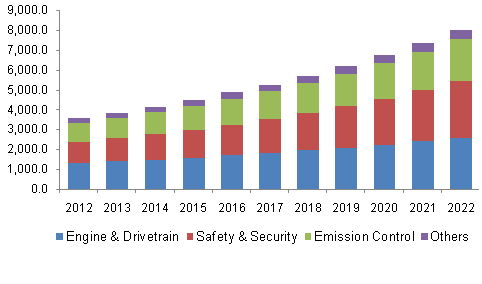May 2020 | Report Format: Electronic (PDF)
The global automotive sensor market size is expected to reach USD 36.76 billion by 2022, according to a new study by Grand View Research, Inc. Favorable government regulations for increasing overall passenger security and safety is expected to augment market demand over the forecast period. These products have become an important part of automobiles, and detect physical parameters such as speed and heat and take preventive measures in case of any danger.
Growing consumer adoption of electric, hybrid and hydrogen fuel-cell-powered motor vehicles is expected to drive demand for battery monitoring. Image sensor-based ADAS systems have become essential for tracking and identifying potential hazards. Additionally, rising number of autonomous vehicles in yielding lower fuel consumption and reduced traffic congestion features in developing countries such as Japan and China is expected to favorably impact the automotive sensor market. Demand for retrofitting of advanced systems into the existing motor vehicle fleet is also expected to augment demand.

Further key findings from the study suggest:
- Advanced proximity and positioning sensors help remotely determine the location of an object, and this segment is expected to grow at a CAGR of over 11.0% from 2015 to 2022. These products include radar, infrared, ultrasonic, and laser devices, and are finding application in detection of objects around vehicles in addition to occupancy sensing.
- Sensors used for safety and security applications monitor wheel speed, occupant position tire inflation, etc. For instance, Jaguar F-type uses these products for blind spot monitoring and close vehicle sensing designed to alert the driver about the presence of another vehicle in an adjacent lane by providing a visual warning indicator in the door’s mirror.
- Asia Pacific is expected to remain the leading regional market through the forecast period. The North American automotive sensor market is characterized by the presence of a stringent regulatory landscape. The U.S. NHTSA is attempting to control driver support technologies and direction of automotive collision avoidance. The government is expected to mandate fitment of V2V safety technology in future cars. In addition, the U.S. Association of Automobile Manufacturers (AMM) is expected to leverage rear-view camera and removing side-view mirrors, which can reduce noise and fuel consumption. Outsourcing of manufacturing process to low-cost countries like Mexico, China, Bulgaria, Malaysia, India or the Dominican Republic due to high labor costs in the U.S. is a key industry trend.
- Major industry participants such as Bosch focus on research and development to ensure product differentiation. The company’s R&D efforts have focused on development of efficient methods for ensuring reliability, precise 3D environment recognition, and securing the electronics architecture through constant plausibility checks on the data supplied. Other key players such as Freescale, Sensata, and Denso Corporation provide products that cater to a wide range of applications, such as ADAS, body electronics, chassis and safety, etc.